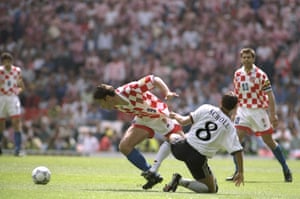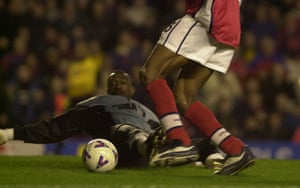[ad_1]
One on one. Man to man. Those phrases suggest integrity, nobility even; a bit of eye contact and generally doing things by the book, as men should. Not in football. In football the best one-on-ones are all about deception. You want honesty, go have a drop ball. A one-on-one offers scope for the simulation it’s OK to like. An attacker has all sorts of tools at his disposal. Stepovers and dragbacks; dummies and shimmies; sleight of foot, hip or eyes. Their weapons also include time – by taking the shot early or delaying it – and even the past, as Diego Maradona and Michael Thomas have shown.
Yet the greater the attempted deception, the more copious the egg on your coupon if it goes wrong – as with a Panenka in a different type of one-on-one, from the penalty spot. You act like the king, you best not miss. This is why the best one-on-one finishers need something more than fast feet and a slow heartbeat. They need something that allows them to take such liberties with a football. It’s round, it has a circumference of 69cm, it weighs between 420 and 445 grammes – and that’s just the left one.
Deception has been behind so many brilliant one-on-one finishes, including those by Alex Del Piero, Luis Figo, Ronaldo, Diego Maradona, Ole Gunnar Solskjær, Claudio López and Peter Beardsley. All magnificent goals, but we particularly heart Davor Suker’s equaliser against Germany in the Euro 96 quarter-final, when he dragged his studs over the ball to completely befuddle Andreas Kopke. It was a masterpiece of arrogance, technique and imagination. Suker had already scored a memorable goal in the group stages, chipping the ball deliciously over Peter Schmeichel to complete Croatia’s 3-0 victory over Denmark. For two weeks in the summer of 1996, impressionable, delicate aesthetes all over England fell madly in love with him – principally for those two finishes and his attempt to lob Schmeichel from the halfway line.
Croatia eventually lost 2-1 to Germany, but all anyone remembers from the game is Suker’s goal. These things matter. Had he simply passed the ball into the net against Denmark and Germany, Croatia’s first appearance at a major tournament would have been largely forgotten outside Zagreb and the immediate environs. Instead it’s still being talked about in list pieces 16 years later.

In a sane and just world, all one-on-ones would involve an attempt to go round the goalkeeper*. Of all the options available to a striker it’s the most emphatic, brooking not a solitary argument. It’s also the most elegant, the most artistic and – we know how important this is to you, dear readers – the most cool. Increasingly, it’s also one of the most unusual. When Paolo Di Canio went past Raimond van der Gouw to score for West Ham against Manchester United, the BBC’s Barry Davies lamented the reluctance of players to do that any more – and that was 13 years ago.
Our favourite example of a player going round the keeper comes from Italia 90. You don’t need Frank Carson to tell you that this was a Careca cracker. It’s not so much a goal as a free-form dance routine: so smooth and gracefully athletic that you can hear the samba beats as you watch it. It’s not just Careca’s movement that stands out. The angle at which he approaches the ball gives the Sweden keeper Thomas Ravelli no clue as to which way he might go – and Careca holds the moment between them for a few seconds with the certainty of a skilled seducer, maintaining eye contact. Then a sudden movement of the right foot, with no backlift, and the ball is whisked away. Now you see it, now you don’t. As Davies said simply: “Brilliantly done, brilliantly done.”
It’s logical that Brazil, the home of individual talent and unfettered expression, should produce so many good one-on-one finishers. But we’re not sure we’ll ever see one quite as slick as this again.
* Or, rather, past the goalkeeper. He doesn’t really go round him, does he? Where does that expression come from anyway?
The little book of clichés tells us Kanu has a good touch for a big man. But who needs a GTFABM when you don’t need to touch the ball at all? There have been a number of fine examples of players going past the keeper without applying leather to leather including George Best, Nicolas Anelka and Jesper Blomqvist. What we love about Kanu’s goal is the irresistible languor. Everything is done in slow motion, and he sits down keeper Jacques Songo’o almost with kindness. All those good touches for a big man filled Songo’o’s head with ideas of what Kanu might do to beat him. As a consequence, he didn’t have to do anything at all.
* Blomqvist 1-0 Pelé, right? Well, sort of. It’s an amazing goal, and deserves to be more celebrated, but Pelé has inventor’s rights – and, just as importantly, his movement is a thing of the rarest athletic beauty. Blomqvist, by contrast, looks like he’s lumbering through a quagmire.

Some people think a one-on-one is about scoring or saving a goal. These poor naïve souls probably leave their back door unlocked and believe in the good of mankind. For many attackers, the one-on-one is a power game. It is not enough to score a goal; they must humiliate the goalkeeper too. In essence, it’s a masculinity-waving contest.
Nobody waved their masculinity more often or more persuasively than Romario. If there has ever been a better one-on-one finisher, we haven’t seen him. Romario could manipulate the ball in a million different ways to get it over, under or either side of the goalkeeper. Watch this video of his one-on-one finishes and – as with the Diego Maradona YouTube game – try to predict what Romario is going to do with each one on one. No chance.
The one thing you could predict is that he would try to dehydrate the keeper. When Barcelona went to Old Trafford in 1994, there was much talk about Romario v Peter Schmeichel, the world’s best striker v the world’s best goalkeeper. Romario did not just score with his only chance, he nutmegged Schmeichel as Schmeichel spread himself as wide as possible. Romario had hoisted Schmeichel by his own technique. It might have been a coincidence. It might.
That had nothing on his goal against Uruguay a year earlier, when he made a complete clown of Roberto Siboldi. The context was a decisive World Cup qualifier. Had Brazil lost they would have failed to quality for the World Cup for the first time. So they recalled Romario, persona non grata for nine months and without a goal for four years. On a fraught night, Romario headed Brazil ahead in the 72nd minute, and with eight minutes to go he sealed their World Cup place.
After running through on goal he knocked the ball past the advancing Siboldi to the right, shaped to go left and then suddenly veered away to the right again. Siboldi did not so much have twisted blood as twisted brain cells. He was so frazzled that, with the ball nowhere near, he dived forward full length and tried to punch Romario off balance. It was like a Benny Hill sketch. Romario evaded his attempt contemptuously and tapped the ball into the net. Of all his brilliant one-on-one finishes, none captures his raison d’etre quite like this.
The one-on-one generally has a loose structure which, although informal, allows the striker to practice the skill in advance. There will be you, there will be a keeper, and you’ll have a few seconds to score. Yet sometimes the goalscoring opportunity comes in such unusual circumstances as that improvisation is the only option. With a nod to Jean Pierre-Papin, Mark Hughes, Leopoldo Luque, Lionel Messi, Roberto Baggio and Thierry Henry, we’ve gone for a nod of Diego Maradona’s head against Milan in 1988.
Maradona loved vaccinating Milan at the best of times. They were Napoli’s main rivals in his time there, and he scored at home to them in each of his last five seasons in Serie A. This was the first meeting between the sides since Milan had taken Napoli’s title – effectively with a 3-2 victory on Napoli’s turf. Maradona’s goal set Napoli on the way to a cathartic 4-1 trouncing.
Even the preamble to the goal is irresistible, with Maradona cracking the code of Milan’s offside trap, the thing that defined them. That will have given him almost as much pleasure as the finish. It’s an extraordinary goal, as 25-yard headers are wont to be. When the ball bounced Maradona probably planned to lob Giovanni Galli, but it had so much backspin that, instead, he strained his neck muscles like an angry Bruce Banner to get the ball over Galli and slowly into the net. Every gentle bounce of the ball goaded Milan and informed them, as if they didn’t already know: I have vaccinated you, again.
Instinct is a footballer’s best friend. Sometimes it gets them into trouble (morning Joey!) but for the most part it is a good thing. It takes care of business 99% of the time and ensures they don’t have to engage the brain. One of the few exceptions is when a player runs through on goal from the halfway line. The good news is that he has time to decide what to do; the bad news is that his inner Costanza has time to tell him how he’s going to mess it up. Tony Cascarino articulates this beautifully in his autobiography, in reference to an infamous miss for Gillingham against Everton. There was a similar gem from – you guessed it – Emile Heskey in 2003.
This is the problem for any player who bursts past a high defensive line. But some goals are bigger than others, and thus, with a nod to Michael Thomas, one example stands out in this sphere: Jorge Burruchaga in the World Cup final of 1986. As he hared on to Diego Maradona’s pass with six minutes to go and the score at 2-2, Burruchaga had all the time in the world to consider the brutal reality of the moment. That, in the next few seconds his career – his life – would be defined: he would either be the man who won the World Cup, or the man who ballsed it up. (Argentina may well have gone on to win in extra-time, although they looked shattered and Maurice Mentum was emphatically with West Germany, who had come from 2-0 down to equalise moments earlier.) Immortality or infamy; nothing in between. He took two touches and stabbed the ball coolly under Harald Schumacher.
Some say Schumacher was slow off his line – having been burned earlier in the match when he came for a free-kick, missed and gave Argentina their opening goal – and that Burruchaga’s second touch was slightly too heavy. Yet that touch satisfied the golden rule of taking the last defender out of the game without bringing the goalkeeper into it. Any softer and Hans-Peter Briegel would probably have been able to attempt a slide tackle – and there are still around three yards between Burruchaga and Schumacher when he shoots, so an earlier Schumacher advance would probably have made no difference.
Either way, who cares? It’s a one-on-one finish and it won the World Cup. The moment all small boys dream of. The fact it came in circumstances that most grown-up footballers might secretly dread makes it even better.
[ad_2]
Source link
